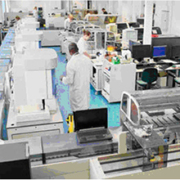Advanced automation system drives lab efficiency while optimizing use of staff time
Following the trend in the US, pressure is mounting on big European hospital labs to consolidate their operations and boost workflow performances while at the same time making better use of their staff. The Aptio Automation system from Siemens Healthcare Diagnostics goes a long way to fulfill these objectives. Here we take a look at three specific examples of hospitals that have integrated the system and how it has helped both their clinical and operational effectiveness
National Health Service (NHS) Tayside
NHS Tayside serves a population of 480,000 through a network of 22 hospitals/infirmaries and 69 general-practice sites that rely on two laboratories. The Blood Sciences Laboratory is located at the 900-bed Ninewells Hospital in Dundee, one of the UK’s major teaching hospitals. Here, Aptio Automation merges the three former individual labs onto a single track, providing a full complement of pre- and post-analytical sample-processing modules along with comprehensive analytics. The efficiencies gained have empowered the Ninewells Hospital laboratory to take on 73% of the testing that historically had been conducted at the 260-bed Perth Royal Infirmary (PRI), enabling the smaller PRI laboratory to focus exclusively on acute admissions and inpatient testing. Ninewells now handles 100% of the general practice testing in the entire region.
“Underpinning all of our actions is the commitment to reduce waste and variation—and most of all, to prevent harm to patients,” says Dr. Bill Bartlett, Tayside’s joint clinical director of diagnostics. “Aptio Automation is helping us enable our vision of cost-effective, patient-focused care.”
Using Aptio Automation, Tayside now processes 7,000 tubes per day—a 20% increase in the workload of its main laboratory with no additional staff. Decreased TAT across the board drove a 61% improvement in the TAT for add-on tests – all with the high-quality results derived from the consistency and standardization enabled by automation. Increased capacity has even enabled Tayside to introduce new testing protocols that improve the quality of care and can save the hospital money.
While Tayside staff had ideas about what they needed and wanted to do, Siemens gave them data-driven information to guide their decision making. “Siemens’ expertise and consultative approach was paramount to the success of this project, from beginning to end,” says Dr. Bartlett. “We relied on them to evaluate workloads from a variety of locations and to recommend the optimal mix of instruments to support peak loads. They devised the final track layout for the new space and helped optimize the use of automation to best manage the workflow.”
Carlos Haya Hospital Malaga
Rising along Spain’s Mediterranean coast, Malaga has a population of approximately 600,000 through tourism, construction, and technology services. The healthcare needs of locals and tourists are met by the 1,100-bed Universitario Carlos Haya Hospital. Part of the government-run Andalusian Public Health System, Carlos Haya is a regional institution with four hospitals: the General Hospital, Civil Hospital, CARE Joseph Estrada, and Hospital Materno Infantil. The latter, in addition to providing healthcare for mothers and infants, houses the core laboratory that serves as the reference lab for all four hospitals. The Carlos Haya General Hospital also operates a biochemistry lab and its own emergency lab.
Hospitals in Spain are classified into three tiers, depending on the complexity of the diseases they can treat. Materno Infantil holds the highest rating, Tier 3, which means it handles the most difficult cases. Its core lab provides testing across a wide spectrum of disease states, performing seven million tests a year for approximately 660,000 patients.
The great leap forward occurred in 2012, with the implementation of Siemens Aptio Automation integrated with the Siemens CentraLink Data Management System. The solution delivers extensive automation, customization, and traceability, while eliminating the need for third-party informatics software.
“Aptio Automation strengthened our preanalytical and analytical phases, giving us more capacity, more versatility, and overall, more possibility,” says Dr. Manuel Rodriguez, who is responsible for biochemistry and automation labs. “CentraLink, meanwhile, makes it much easier to manage quality. It facilitates sample follow-up and management of repetitions. With CentraLink control over instrument alarms, we gain comprehensive information on the situation of a particular sample. What’s more, the solution is simple, problem-free, and easy to use.”
Hospital Clinic de Barcelona (CDB)
In 2001, the Hospital Clinic de Barcelona in Spain was among the first healthcare providers in the world to create an automated core laboratory. Today the laboratory is gaining even greater efficiencies with Aptio Automation connecting analytical systems across all four core laboratory disciplines: clinical chemistry, immunoassay, hematology, and hemostasis.
Over the course of its 13-year journey with Siemens, the laboratory has been able to consolidate instruments, integrate and automate STAT testing, reallocate staff to higher-value responsibilities, and save upwards of €600,000 in tube costs – all while increasing clinicians’ trust in the laboratory to support excellence in patient care.
In 2000, Hospital Clinic de Barcelona established the Biomedical Diagnostic Centre (CDB) to provide high-quality, comprehensive service in all areas of laboratory medicine and to be a reference for excellence in the related specialties. The CDB uses a client-focused model to optimize the use of resources while ensuring advanced technological development in healthcare and research.
The CDB is divided into five specialty departments and an operative core laboratory where high-volume automated testing is performed. In total, the CDB is composed of 100 staff specialists from the various laboratory areas along with 300 professionals representing pathology, biochemistry, molecular genetics, hemotherapy and hemostasis, immunology, and microbiology specialties.
The CDB recently began a project to create a Molecular Biology Core Laboratory, which will integrate the most frequently tested molecular technologies.
“Economic pressure is an ongoing fact of life,” says Dr. Aurea Mira, director of the CDB. “Lab automation allows us to improve workflows, optimize human and technology resources, and save money. It also raises hospital awareness of the lab as a provider of fast, accurate testing that supports good clinical outcomes.”



